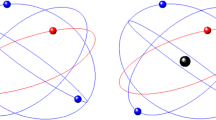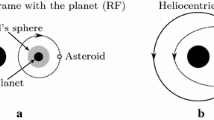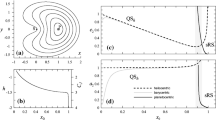Abstract
We derive general results on the existence of stationary configurations for N co-orbital satellites with small but otherwise arbitrary masses m i , revolving on circular and planar orbits around a massive primary. The existence of stationary configurations depends on the parity of N. If N is odd, then for any arbitrary angular separation between the satellites, there always exists a set of masses (positive or negative) which achieves stationarity. However, physically acceptable solutions (m i > 0 for all i) restrict this existence to sub-domains of angular separations. If N is even, then for given angular separations of the satellites, there is in general no set of masses which achieves stationarity. The case N=3 is treated completely for small arbitrary satellite masses, giving all the possible solutions and their stability, to within our approximations.
Similar content being viewed by others
References
Albouy, A.: 1996, ‘The symmetric central configurations of four equal masses', Hamiltonian Dyn. Celest. Mech. Contemp. Math. 198, 131–135.
Albouy, A. and Llibre, J.: 2002, ‘Spatial central configurations for the 1+4 body problem'. In: Celestial Mechanics Evanston, IL, 1999. Contemporary Mathematics, Vol. 292, American Mathematical Society, Providence, RI, pp. 1–16.
Benettin, G., Fassò, F. and Guzzo, M.: 1998, ‘Nekhoroshev-stability of L4 and L5 in the spatial restricted 3-body problem', Reg. Chaot. Dyn. 3, 56–72.
Hall, G. R.: 1987, ‘Central configurations in the planar 1 + n body problem', Boston University preprint.
Maxwell, J. C.: 1859, ‘On the stability of the motion of Saturn's rings'. In: S. G. Brush, C. W. F. Everitt and E. Garber (eds), Maxwell on Saturn's Rings, The MIT Press, pp. 69–158.
Moeckel, R.: 1994, ‘Linear stability of relative equilibria with a dominant mass', J. Dyn. Diff. Eq. 6(1), 35–51.
Roberts, G. E.: 1999, ‘A continuum of relative equilibria in the 5-body problem', Physica D 127(3-4), 141–145.
Roberts, G. E.: 2000, ‘Linear stability in the 1+n-gon relative equilibrium', Hamiltonian Syst. Celest. Mech. World Scient. Monogr. Ser. Math. 6, 303–330.
Salo, H. and Yoder, C.F.: 1988, ‘The dynamics of coorbital satellite systems', Astron. Astrophys. 205, 309–327 (SY88).
Author information
Authors and Affiliations
Rights and permissions
About this article
Cite this article
Renner, S., Sicardy, B. Stationary Configurations for Co-orbital Satellites with Small Arbitrary Masses. Celestial Mechanics and Dynamical Astronomy 88, 397–414 (2004). https://doi.org/10.1023/B:CELE.0000023420.80881.67
Issue Date:
DOI: https://doi.org/10.1023/B:CELE.0000023420.80881.67




